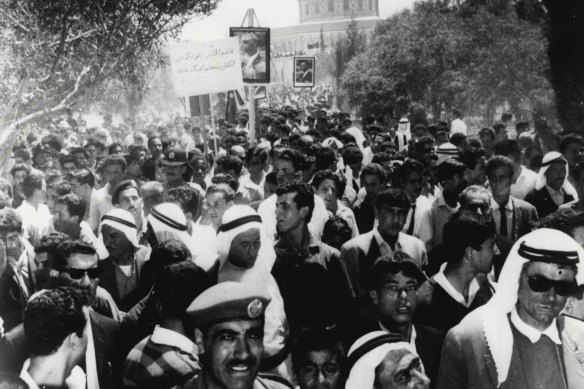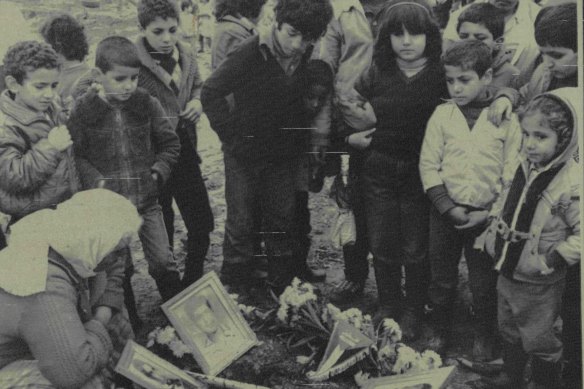

Thousands of Palestinians, many firing pistols and carrying sabres, march through Arab Jerusalem in 1968 calling for a “Holy War”.Credit: United Press International
1973
Disguised Israeli special forces shoot dead three Palestinian guerrilla leaders in Beirut in retaliation for the killing of 11 Israeli athletes at the 1972 Munich Olympics.
Palestinian guerrilla raids into Israel and Israeli military reprisals on targets in Lebanon intensify during the 1970s, leading many Lebanese to flee their country’s south and aggravating sectarian tensions in Lebanon, where civil war is starting.

The Olympic flag flies at half-mast (right) in Munich during a memorial for the Israeli athletes killed in the Palestinian commando raid during the 1972 Olympics.Credit: AP Cablephoto
1978
Israel invades south Lebanon and sets up a narrow occupation zone in an operation against Palestinian guerrillas after a militant attack near Tel Aviv. Israel backs a local Christian militia called the South Lebanon Army (SLA).
1982
Israel invades Lebanon all the way to Beirut in an offensive that followed tit-for-tat border fire.
Thousands of Palestinian fighters are evacuated by sea after a bloody 10-week siege of the Lebanese capital involving heavy Israeli bombardment of West Beirut.
Hundreds of civilians in the Palestinian refugee camps of Sabra and Shatila are massacred by Christian militiamen allowed in by Israeli troops after Lebanon’s newly elected Maronite Catholic president is killed by a car bomb.

At a mass grave in Chattila refugee camp for victims of the Palestinian massacre in 1983, an elderly Palestinian women weeps over photographs of men killed by Christian militiamen.Credit: AP Wirephoto
Iran’s Revolutionary Guards establish the Shiite Muslim armed group Hezbollah in Lebanon to counter the Israeli invasion.
1985
Israel pulls back from central Lebanon in 1983 but retains forces in the south. It establishes a formal occupation zone in southern Lebanon, about 15km deep, controlling the area with its SLA ally. Hezbollah wages guerrilla war against Israeli forces.
1993
In July Israel launches “Operation Accountability”, a week-long attack by its forces against Lebanon. Israel says the aim is to strike directly at Hezbollah, to make it difficult for the group to use southern Lebanon as a base for striking Israel, and to pressure the Lebanese government to intervene against the group.
1996
With Hezbollah regularly attacking Israeli forces in the south and firing rockets into northern Israel, Israel mounts 17-day “Operation Grapes of Wrath” offensive that kills more than 200 people in Lebanon, including 102 who die when Israel strikes a UN base near the south Lebanon village of Qana.
2000
Israel withdraws from southern Lebanon, after continued attacks on Israeli military positions in occupied Lebanese territory by Hezbollah, ending 22 years of occupation.
2006
In July, Hezbollah crosses the border into Israel, kidnaps two Israeli soldiers and kills others, sparking a five-week, or 34-day, war involving heavy Israeli strikes on both Hezbollah strongholds and national infrastructure.
While Israeli ground forces move into southern Lebanon, much of the conflict is conducted by Israeli airstrikes and Hezbollah rocket fire. It ends without Israel achieving its military objectives and with Hezbollah declaring it a “divine victory”.
At least 1200 people in Lebanon, mostly civilians, and 158 Israelis, mostly soldiers, are killed.
2024
Hezbollah declares solidarity with Hamas, after the Palestinian militant group’s attack on southern Israel on October 7, 2023, which takes some 250 hostages and kills about 1200 people.
Hezbollah sustains a limited campaign of missile volleys into Israel which it says will not stop until Israel ends the war it launched in Gaza to eliminate Hamas. Israel’s offensive has killed more than 41,500 people, with the majority of identified victims being women and children.
Israel declares it expanded its war goal to destroy also Hezbollah. It is accused of masterminding attacks via exploding Hezbollah-issued pagers and walkie-talkies that kill hundreds in Lebanon. It expands its airstrikes into southern Lebanon and Beirut aiming at the group’s infrastructure and personnel and kills several commanders, including Nasrallah, its founder. Hezbollah continues rocket-launching into Israel.









 Add Category
Add Category